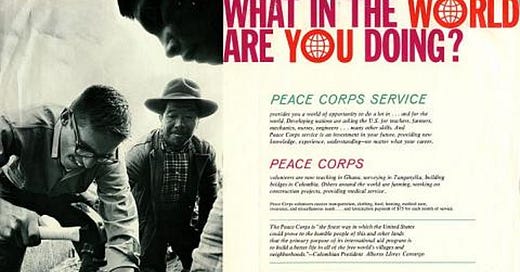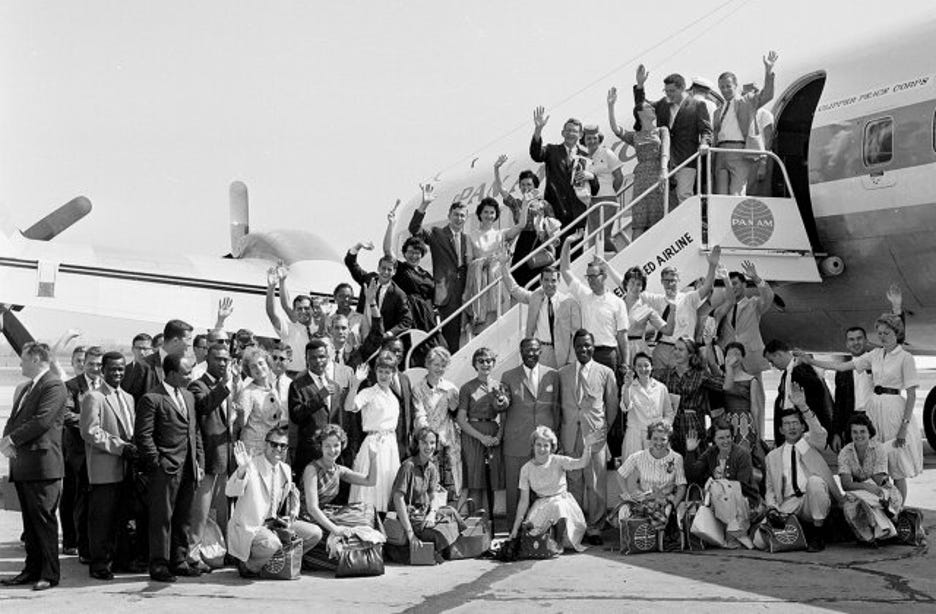Diplomacy Without Suits: The Peace Corps and America’s Retreat from Service
As the U.S. turns inward and becomes more isolationist, one of its most trusted global tools, person-to-person diplomacy, is fading.
By Evan Buckingham
In 1961, the Peace Corps began as a bold experiment in grassroots diplomacy —built not on control or compliance, but on proximity, patience, and person-to-person connection. President John F. Kennedy pitched it as both a moral calling and a strategic investment. It was an opportunity for the U.S. to “help others help themselves,” while demonstrating that American values were worth exporting—not through coercion, but through cooperative action.
That vision was codified in Executive Order 10924, signed on March 1, 1961, which formally established the Peace Corps. At the time, it stood out as a foreign policy tool defined not by force or economic leverage, but by civic humility. As U.S. News has noted in its historical review of the Peace Corps’ founding, JFK pushed the program forward despite internal skepticism, calling it “not simply idealism, but a bold strategy for peace.” He also made clear-eyed demands of those who would serve, stating that applicants must possess "the personal qualities which will enable them to represent the United States abroad with honor and dignity." It was a defining act of presidential vision—one that used executive authority to redefine how the U.S. could lead through service and humility.
Today, more than six decades later, that experiment is being sidelined. It is part of the cuts proposed in the “One Big Beautiful Bill” (or OB3 for short). If we let the Peace Corps disappear, we’ll lose more than a federal program—we’ll lose one of the last credible tools we have for rebuilding global trust from the ground up.
As Jeremi Suri wrote in Rescuing America’s Reputation, our standing in the world has eroded—not just because of who leads the U.S. at any given moment, but because of how inconsistently we show up. The Peace Corps used to be part of the answer. Now it’s a mirror reflecting the values we have abandoned.
A Mission Built on Humility and Reciprocity
The Peace Corps has operated with a human-scale mandate, grounded in three goals:
To help the people of interested countries in meeting their need for trained men and women.
To help promote a better understanding of Americans on the part of the peoples served.
To help promote a better understanding of other peoples on the part of Americans.
These goals weren’t just idealistic slogans. They were a framework for something very powerful: diplomacy rooted in mutuality, not dominance. As Kofi Annan once said, “The Peace Corps represents some of the best of the American spirit: a spirit of service, a spirit of hope, and a spirit of understanding across borders.”
The first goal speaks to capacity-building, but with humility. The Peace Corps wasn’t about exporting models. It was about offering people, time, and a willingness to work collaboratively with local leadership. Volunteers were embedded within communities, rather than being dispatched to them. They taught, learned, and co-created alongside host communities. The Peace Corps acted as guests, not conquerors.
The second and third goals are the heart of the agency’s soft power value: mutual understanding. These are more critical than ever in a world where misinformation spreads faster than fact, and where American intentions are often questioned abroad. When a volunteer spends two years in a remote community, living simply and building trust, that changes how America is perceived. And when they return, it changes how Americans perceive the world.
As Barack Obama put it on the Peace Corps' 50th anniversary: “The Peace Corps represents a core part of our American identity: the idea that we can reach out and help others not with a clenched fist, but with an open hand.”
What America Used to Stand For
In The American Brand Is Changing, I wrote about how America’s global image has shifted—from aspirational to ambivalent. The Peace Corps offered a counter-narrative—one that put a human face on U.S. engagement in places where foreign policy felt distant or extractive. It grounded abstract promises in real people and relationships. It showed that American involvement didn’t have to mean resource grabs or regime changes; it could mean service, solidarity, and shared effort.
That narrative is now unraveling. And it’s not just the Peace Corps that’s under threat. In April 2025, the Department of Government Efficiency (DOGE) announced nearly $400 million in cuts to AmeriCorps—another pillar of national service. The result: over 1,000 community programs were shuttered and 32,000 service members were displaced. In Virginia, Aspire Afterschool Learning lost 17 AmeriCorps members, derailing support for 150 students. Programs in San Antonio targeting public health and education were similarly gutted.
These aren’t just budget cuts. They are declarations about what we value and what we’re willing to discard. The cuts contradict any serious interpretation of 'America First.' If we’re not investing in the people and programs that strengthen our communities and our global credibility, then what exactly are we protecting?
A 2025 report warned that Peace Corps budget proposals could result in a one-third reduction of its staff, jeopardizing efforts to restart paused country programs and preserve decades of institutional knowledge. According to the National Peace Corps Association, many programs remain stalled or dangerously underfunded. Reentry pipelines are broken, and bipartisan support has eroded into political apathy.
The damage isn’t confined to Washington. Host-country staff, often the cultural and operational backbone of these programs, have been hit hard. Many have lost their jobs. Others face steep pay cuts. From the outside, their roles may appear supplemental. In reality, they provide economic stability and cross-cultural continuity in communities where both are scarce.
Former Liberian President Ellen Johnson Sirleaf said it best: “Peace Corps volunteers didn’t just teach—they listened, learned, and became part of our communities.”
That’s what we risk losing. Not just the technical assistance, but the trust.
International reputation isn’t built through policy statements. It’s built through consistency. Through showing up when there’s no immediate return. The Peace Corps has done that for over 60 years. Letting it decay—through neglect, apathy, or budgetary erosion—is more than a missed opportunity. It’s a warning sign that America no longer values the kind of influence that isn’t evident in quarterly corporate earnings.
Being a Peace Corps volunteer doesn’t just result in Hallmark Channel stories; in fact, the stories can span all cable channels. What Peace Corps volunteers bring back is systems-level understanding, practical skills in cross-cultural navigation, resourcefulness, and diplomatic preparation for leadership. These are qualities the U.S. cannot afford to diminish, especially when they are already in short supply.
Why It Still Matters
I served in El Salvador, and I worked in finance and development across Latin America. I don’t view the Peace Corps through a nostalgic lens. I see its shortcomings. But I also know what it does well: it trains Americans to show up differently.
In From Dream to Disillusionment, I wrote about the growing dissonance between what America says and what it does. The Peace Corps is one of the few institutions that narrows that gap. It isn’t perfect, but it’s consistent.
What Comes Next
The Peace Corps doesn’t need to be preserved in stone. JFK built the Peace Corps on wonder, but wonder needs guardrails. It requires courage, clarity, and a future-facing plan.
The Peace Corps must evolve with stronger safety systems, modern tech, and renewed strategic purpose. However, it also requires protection, and protection necessitates funding.
JFK framed this kind of service as foundational to America’s identity:
“What kind of peace do we seek? Not a Pax Americana enforced on the world by American weapons of war. Not the peace of the grave or the security of the slave. I am talking about genuine peace… the kind of peace that makes life on earth worth living.”
That kind of peace isn’t abstract. It requires presence. It requires service. It requires a policy vision that stretches beyond the next election cycle.
The Peace Corps is one of the last tools we have that still does that. It’s not charity. It’s not performance. It’s the quiet power of showing up—again and again, even when no one is watching.
And in a world increasingly defined by withdrawal, that might be the most powerful kind of leadership we have left.
Take Action
To support the Peace Corps at this pivotal moment, consider getting involved:
Reach out to your local Returned Peace Corps Volunteer (RPCV) chapter to learn more about local service and advocacy efforts.
Support the National Peace Corps Association (NPCA) by making a donation or sharing their legislative updates.
Contact your congressional representatives and ask them to support full funding for the Peace Corps. Congressional action will directly impact whether country programs are restored or lost.
Service shouldn’t be partisan. If we still believe in diplomacy, development, and mutual understanding, then we have to prove it—especially now.
Evan Buckingham brings a depth of lived experience to his writing, shaped by his time in the Peace Corps in El Salvador, leadership roles in multinational firms, and finance work across Puerto Rico and Boston. His career spans cultures, sectors, and scales, providing him with a global lens on policy, economics, and service. A lifelong learner and advocate for strong, empathetic leadership, Evan first connected with Jeremi during a course at the University of Texas at Austin, where their shared commitment to thoughtful discourse took root.







